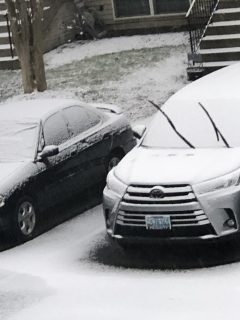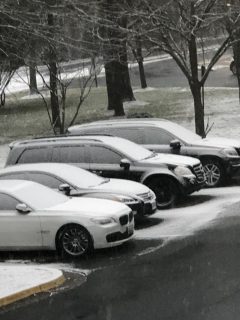In fact, the National Weather Service is forecasting “snow accumulations through Sunday night of around 4 to 6 inches with ice accumulations of a light glaze” across the Washington metro area. So expect potentially dangerous winter weather and stay off the roads, warns AAA Mid-Atlantic. Snow and freezing precipitation can cause a big safety problem on area freeways, secondary roadways, and neighborhood streets. What is more, vehicles that get stranded or stuck in the snow unnecessarily impede road crews and emergency responders from doing their jobs safely and effectively.
But essential workers must tackle the trek to their duty stations during major snowstorms. In most states and localities, essential workers include: “police and emergency management personnel, staff working in prisons, hospitals, pharmacies, and residential services as well as highway and road crews responsible for clearing state roads and maintaining mandatory operations.” Plus, news crews.
It behooves area residents and local motorists to heed the warnings from the National Weather Service (NWS). “Travel will be very difficult Sunday through Tuesday morning due to a prolonged period of snow and wintry precipitation with temperatures near or below freezing,” the NWS forewarns. Prepping your vehicle for driving in wintry conditions is great, but you shouldn’t overlook prepping yourself. For example, you also shouldn’t drive if you’re fatigued. That’s a bad idea any time, especially when inclement weather calls for drivers to be alert.
“Many drivers will face the daunting task of negotiating snow-covered, slick roadways and dangerous conditions across the region,” cautioned John B. Townsend II, AAA Mid-Atlantic’s Manager of Public and Government Affairs. “If you must go, put your safety and the safety of others first, check the local weather forecast and current conditions before venturing out, and prepare for any exigency and brace yourself for any emergency scenario.”
“Clear all snow from your vehicle. Slow down. Increase your following distance by 10 seconds on snow or ice. If you find yourself in a skid, don’t panic. Look and steer where you want to go. Avoid slamming on the brakes. Take your time. Make sure your gas tank and wiper fluid tank are full to the brim, pack an emergency kit, and keep a bag of sand or cat litter, a shovel and traction mats in your trunk or cargo area, in case you get stuck in snow or ice.”
Once the snow starts falling in Northern Virginia, Maryland and the District of Columbia, and across the mid-Atlantic region, snowplows, dump trucks, road graders and tow trucks will be in full operational mode in Maryland, Virginia, and in the nation’s capital. By the onset of the storm, the Northern Virginia division of the Virginia Department of Transportation’s (VDOT) is staging more than 1,850 trucks ready to treat road. Crews will begin to plow once two inches of snow have accumulated. The public should expect disruptions and delays as the storm progresses.
Drivers should know the safety rules for dealing with winter road emergencies. AAA Mid-Atlantic is urging drivers to be cautious while driving in adverse weather. Here is the first road rule: Stay Home and Stay Put. Only go out if necessary. Even if you can drive well in bad weather, it’s better to avoid taking unnecessary risks by venturing out. But if you are an essential worker and duty calls, AAA provides the following tips while driving in snowy and icy conditions:
How to Drive Safely in Winter Conditions:
-
Remove all ice and snow from your vehicle before you start driving.
-
To defrost your windows, set the temperature control to hot and let the engine warm up, which helps keep frost from forming inside.
-
If the windshield and side windows fog on the inside, open a window slightly and set the fan to a higher speed.
-
During snow or other low-visibility winter driving conditions, drive with your low-beam headlights on to make it easier for other drivers to see you.
-
As you would before any drive, adjust your seat so that you are no closer than 10 inches to the steering wheel and you can clearly see the road.
-
Brake, accelerate and steer gently, gradually and smoothly.
-
Watch the traffic ahead of you. Slow down immediately – but again, moderately – at the sight of brake lights, skidding vehicles or emergency lights.
-
Put down your phone. Do not send or read text messages, or engage in other distracting behavior.
-
If you encounter a snowplow or salt trucks, allow plenty of space and don’t try to pass.
-
Clean your headlight lenses periodically, such as when you stop for gas, to remove grime from slushy streets. Clear any snow and ice from your vehicle as well, as it can fly off and strike other vehicles.
-
Obey the Basic Speed Law any time there’s a possibility of snowy or icy roads. This means never traveling at speeds that aren’t reasonable and safe for conditions.
-
It’s important to reduce speed because you may encounter patches of black ice that are difficult or impossible to see. Bridges, ramps, overpasses and shaded areas may become icy before other surfaces.
-
Be cautious at intersections, where stopping and starting vehicles can polish the ice, making it slicker.
-
Wind gusts can make steering on ice more difficult, so it’s critical to reduce speed during windy conditions. Be aware that buildings can cause sudden changes in wind direction.
-
Be visible if you get stranded or stuck. Tie a brightly colored cloth to the antenna of your vehicle or place a cloth at the top of a rolled up window to signal distress. At night, keep the dome light on if possible. It only uses a small amount of electricity and will make it easier for rescuers to find you.
Before you start your trip, make sure your vehicle is prepared for safe travel.
-
Make sure your gas tank is full, or at least make full, to avoid running out of gas, or a frozen gas line, or potential gas station lines.
-
Check the tread on your tires and replace them if necessary.
-
Make sure your windshield and rear window defrosters are in proper working condition.
-
Keep plenty of windshield washer fluid in your reservoir and don’t dilute the solution with water.
If you get stranded or stuck in the snow:
-
Call out the Cavalry. That is, your roadside assistance provider. Your AAA membership covers you with 24/7 roadside assistance. If you need us, request service quickly and easily. For AAA Mid-Atlantic emergency roadside assistance service, please call 1-800-222-4357, or visithttps://bit.ly/3jIf0QO.
-
Stay with your vehicle: Your vehicle provides temporary shelter and makes it easier for rescuers to locate you. Do not try to walk in a severe storm. It is easy to lose sight of your vehicle in blowing snow and become lost.

-
Don’t over exert yourself: When digging out your vehicle, listen to your body and stop if you become tired.
-
Be Visible: Tie a brightly colored cloth to the antenna of your vehicle or place a cloth at the top of a rolled up window to signal distress. At night, keep the dome light on if possible. It only uses a small amount of electricity and will make it easier for rescuers to find you.
-
Clear the Exhaust Pipe: Make sure the exhaust pipe is not clogged with snow, ice or mud. A blocked exhaust pipe can cause deadly carbon monoxide gas to leak into the passenger compartment of the vehicle while the engine is running.
-
Stay Warm: Use whatever is available to insulate your body from the cold. This could include floor mats, newspapers or paper maps. Pre-pack blankets and heavy clothing to use in case of an emergency.
-
Conserve Fuel: If possible, only run the engine and heater long enough to remove the chill. This will help to conserve fuel.
What To Have In Your Car Emergency Kit:
More than 40 percent of motorists do not carry an emergency kit in their vehicle. AAA recommends having an emergency kit in your vehicle and provides this list of things to include and tips on where to stow them. Be sure to replenish any depleted items as needed.
- Cell phone and car charger (glove compartment).
-
Jumper cables/jump pack (trunk or luggage area).
-
Ice scraper/snow brush (inside vehicle).
-
Traction aid, such as sand, salt, or non-clumping cat litter.
- Basic set of tools along with duct tape and car emergency warning devices such as road flares or reflectors (luggage area).
-
First-aid kit (glove compartment).
-
Blanket (luggage area).
-
Tarp, winter coat/raincoat and gloves.
-
Drinking water/snacks for everyone in the vehicle, including pets (some in glove compartment, the rest in the luggage area).
- Flashlight with extra fresh batteries.
- Rags, paper towels or pre-moistened wipes.
Winter storms, bad weather and sloppy road conditions are a factor in more than 2,000 road deaths, and nearly half a million crashes every winter in the United States. That’s according to research by the AAA Foundation for Traffic Safety.
Ahead of the winter storm, VDOT Northern Virginia crews pretreated roads in Arlington, Fairfax, Loudoun, and Prince William counties Saturday. VDOT advises this will help prevent ice and snow from bonding to the pavement at the onset of the storm. VDOT’s Northern Virginia District maintains more than 14,000 lane miles of roads in Arlington, Fairfax, Loudoun and Prince William counties.
To provide safety and mobility for motorists on state-maintained roads, county-maintained roadways and local roads in Maryland during the winter storm, it will be all-hands-on deck for snow emergency road crews.
To clear streets of snow and ice to promote safe vehicular travel, the District will deploy snow-fighting equipment, and snow clearing crews and snow plow operators along major corridors, snow emergency routes
(SERs), and neighborhood streets. Residential and commercial property owners in the nation’s capital are asked to clear their sidewalks within 24 hours of a storm’s end so pedestrians can walk safely.
AAA provides automotive, travel, and insurance services to 61 million members nationwide and nearly 84,000 members in the District of Columbia. AAA advocates for the safety and mobility of its members and has been committed to outstanding road service for more than 100 years. AAA is a non-stock, non-profit corporation working on behalf of motorists, who can now map a route, find local gas prices, discover discounts, book a hotel, and track their roadside assistance service with the AAA Mobile app (AAA.com/mobile) for iPhone, iPad and Android. For more information, visit www.AAA.com.




